
e process of writing a work consists of interweaving personal ideas on a subject and appropriating those of specialists, journalists or other authors to paraphrase them. This reformulation must be done well to avoid plagiarism.
![]() Goals
Goals
![]()
Before writing, it is recommended to develop a detailed plan to order and structure your ideas in a logical and coherent way.

Generally speaking, the introduction to a work will consist of 3 parts. The first part, the subject brought , will consist of introducing your subject without naming it. For example, the subject can be brought up using a statistic, a historical link or even a current event. The second part, the posed subject , will aim to explicitly name its subject and the way in which it will be approached by indicating the type of work requested (summary, criticism, essay, etc.) The third part, the divided subject , will allow us to name the main ideas of development without explaining them. In short, the introduction can be seen as a funnel in which the subject will be approached from the most global to the most specific.

The development will differ depending on the type of work requested (summary, critique, essay, etc.) Generally speaking, the first sentence of the paragraph will be used to name the main idea addressed and the subsequent sentences will explain this main idea, to argue, make theoretical connections, illustrate using examples, give your opinion or other depending on the type of work requested (summary, critique, essay, etc.). It is therefore important to refer to the requirements of the work to clearly target the nature of the development (argumentative, informative, opinion text, etc.)

The conclusion will have 2 parts. The first part will serve to summarize in a few sentences the main ideas of the text. The second part will be an opening towards an idea which has not been developed and which is linked to the subject of the text. For example, it could be a link to the job market, internships, personal experience, a notable quote, etc. Finally, the conclusion can be thought of as an inverted funnel in which the topic will be restated specifically and then globally.
![]()
For more information on how to write a work, do not hesitate to listen to the capsules offered by the Learning Support of the Office of Inclusion and Student Success (BIRÉ) and to consult these Useful resources for writing .
![]()
Paraphrasing is “changing the wording of a message without changing its meaning”. ( Termium )
To paraphrase, it is therefore important to understand the original text well and to use rewriting tips.
![]()

![]()
Regardless of the method used, always indicate the reference of the paraphrased text.

![]()
To ensure writing consistency and keep the text understandable, minor edits may need to be made to the citation. For example, words must be added or deleted or pronouns need to be clarified.
Mark any modification of a quotation with square brackets [ ].
![]()
Make this addition to:
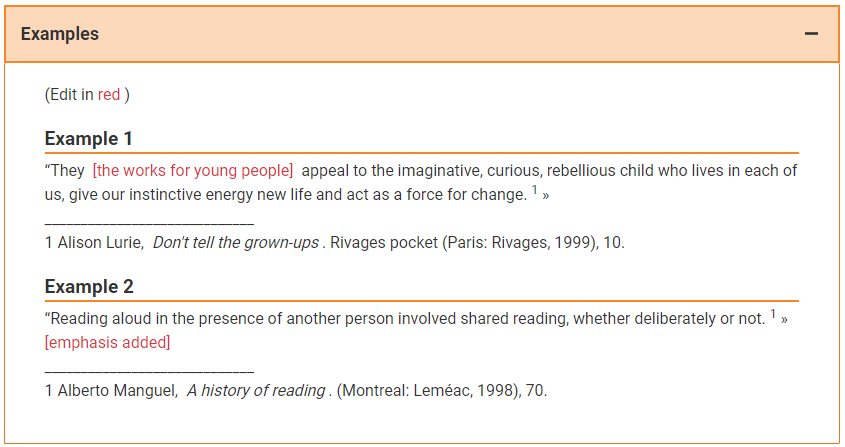
![]()
Make changes to pronouns, determiners and/or verb endings.
Don't overuse it.
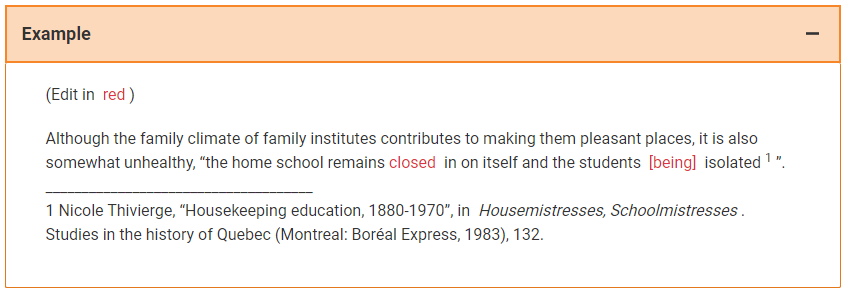
![]()
Ignore any part of the text that is not essential to the citation.
Use the ellipsis in square brackets […] to replace the deleted part of the quotation.
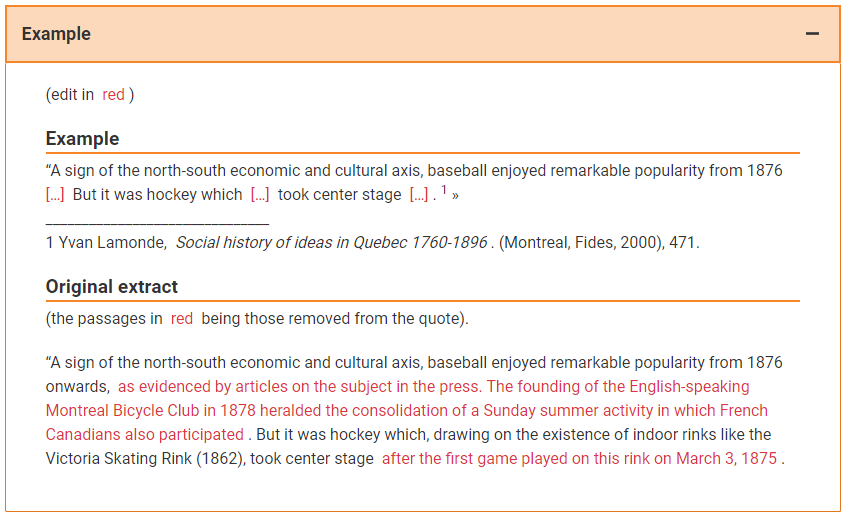
![]()
Infosphère / https://infosphere.uqam.ca 
Infosphère / https://infosphere.uqam.ca
There are many resources available to help with writing. This section offers a selection of the most relevant resources.
![]() Objective
Objective
![]()
This table indicates for each suggested dictionary the main attraction that characterizes it and suggests resources to consult.

![]()

![]()
Several writing aid tools are available on the Web but not all are of equal quality. Federal and provincial institutions provide excellent ones that deserve to be better known
Tool from the Office québécois de la langue française of the Government of Quebec: Linguistic showcase
![]()
Books or web pages to consult for writing advice according to the type of work to be done.
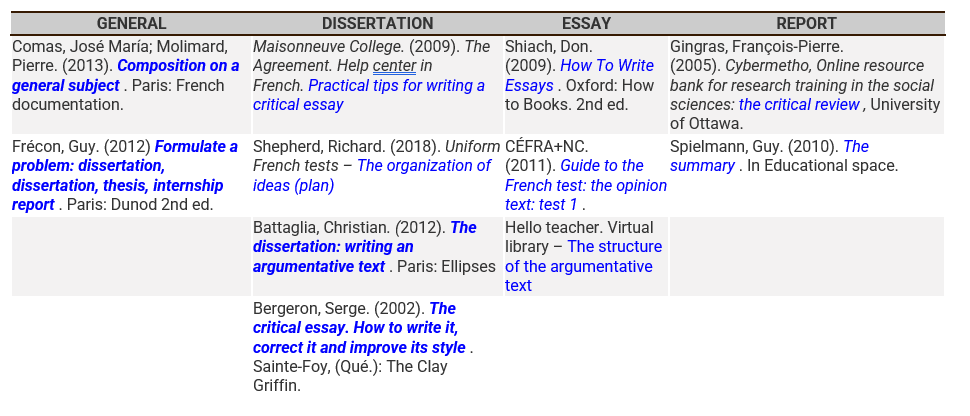
![]()
Infosphère / https://infosphere.uqam.ca
Mentioning the source of information used in writing work can take different forms. This section explores the general principles and shows concretely how to insert and format quotes.
![]() Objective
Objective
![]()
![]()
Quotation is the “action of quoting, reporting someone’s words or sentences; words, passages borrowed from an author or someone who is an authority.” Little Robert
![]()
Above all, to avoid ending up with an academic infraction sanction ranging from probation to expulsion and seeing a permanent mention in the university record. But also for :
![]()
The source must be cited whenever an idea or research result of which we are not the author directly influences the content of our work.
To quote:
Do not quote:
![]()
![]()
In research work, you must indicate the source of citations in 2 places:
The method chosen, either author-date, classic or numbered, always determines the formatting of the source.
![]()
Paraphrasing is when an author's idea is reported in our own words.
Click on a method to view the corresponding citation practice.
![]()
In the case of a quote copied verbatim, the formatting must take into account the length of the extract.
Short quote (less than three lines)
Long quote (three lines or more):
![]() Golden rule
Golden rule
Each line quoted verbatim should be associated with at least two lines of analysis ( plagiarism.org )
![]()
![]()
To cite a quotation for which the original source is not available, credit not only the source from which it was taken, but also the original source. Use phrases like “cited in” or “cited by.” However, only the source actually consulted will appear in the bibliography. The original source is integrated into the text or as a footnote. See the following examples.
Text content
![]() In the bibliography, indicate only the source that was consulted and not the source of the quote already cited by someone.
In the bibliography, indicate only the source that was consulted and not the source of the quote already cited by someone.
Tables and/or graphs
![]() Use the formula “taken from” to introduce mention of the source.
Use the formula “taken from” to introduce mention of the source.
![]()
Language understood by readers
There is no need to translate the passage when it is reasonable to believe that our readers understand the original language of the quoted extract.
The same rules as for text quoted verbatim apply.
Original language that cannot be understood by readers
Knowing that the original language is misunderstood by readers, find a translation of the extract already published and cite it. If there is no translation, translate the extract yourself and put it in quotation marks. Add the mention [My translation].
![]()
When the text contains an error, do not correct it. Any doubtful term (mistake, typo, etc.) must be followed by [sic] to indicate that the original text is indeed worded this way.
![]()
Separate verses with an oblique slash preceded and followed by a space.
![]()
Infosphère / https://infosphere.uqam.ca
1
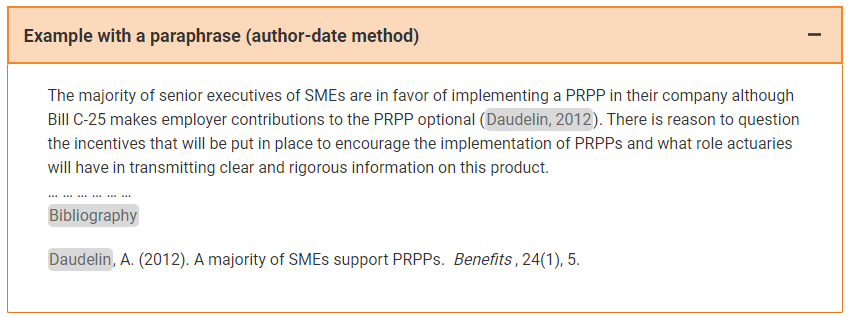
2
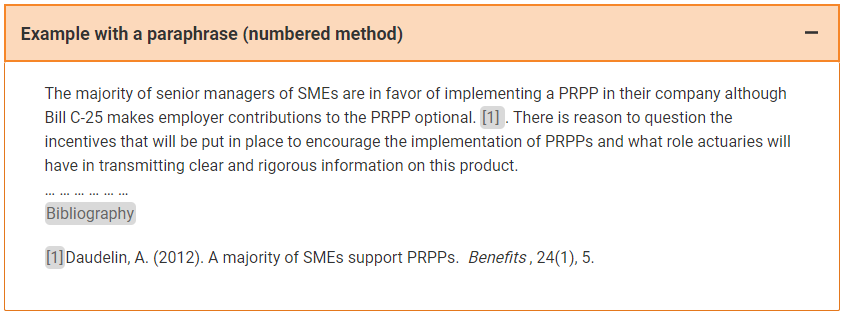
3
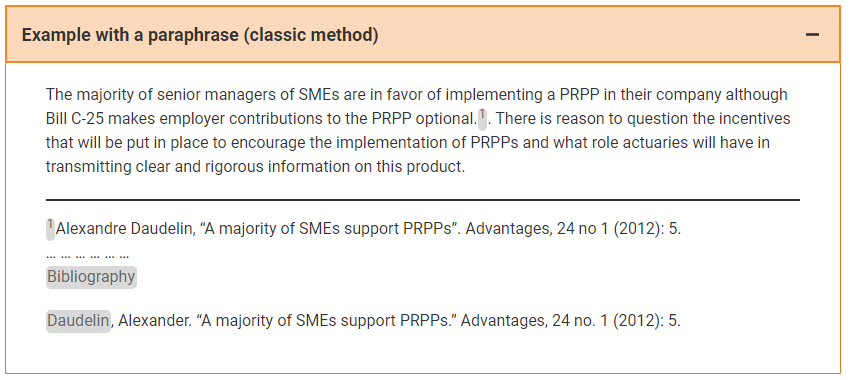
4

5

6

7

8

9

10
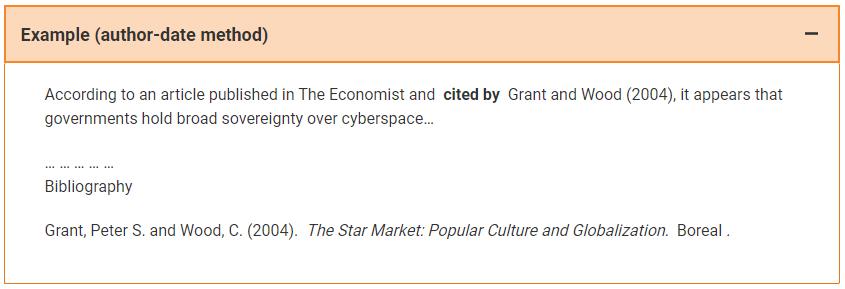
11

12
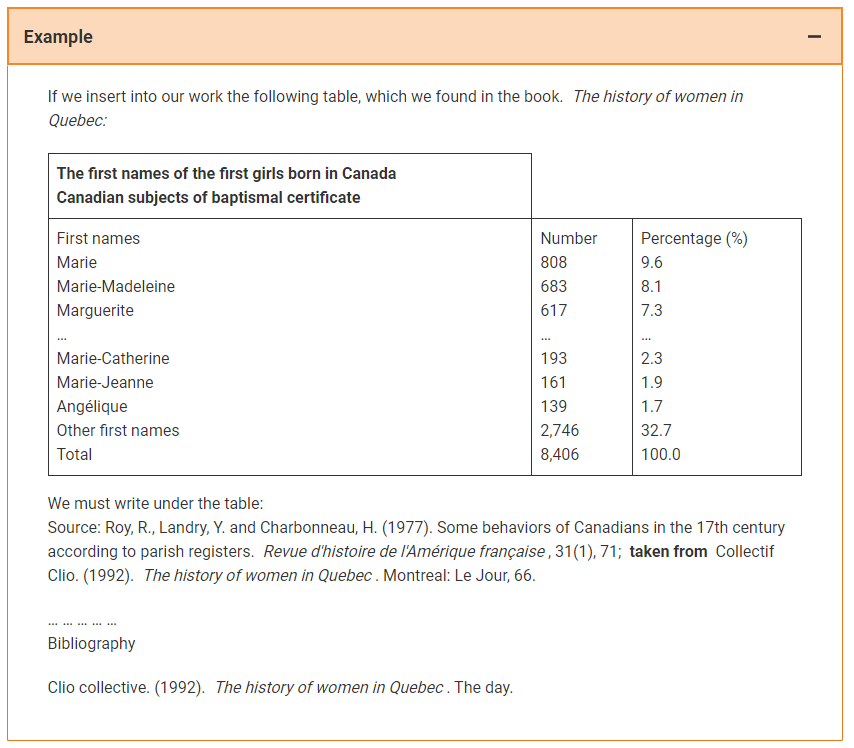
13
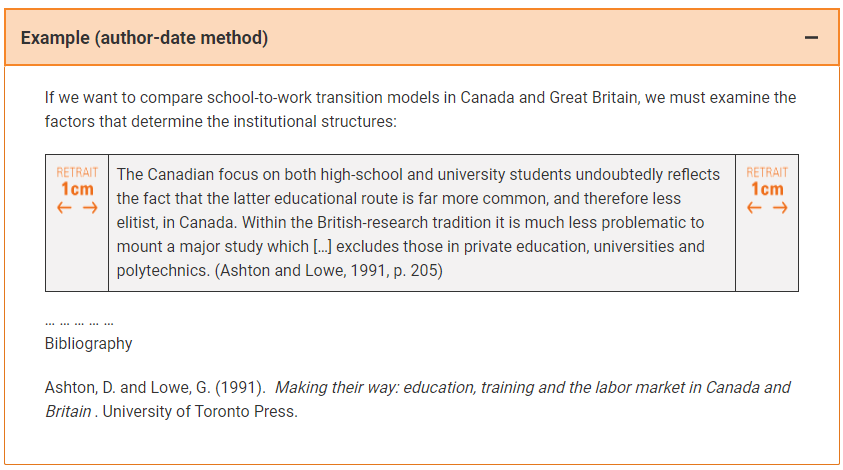
14
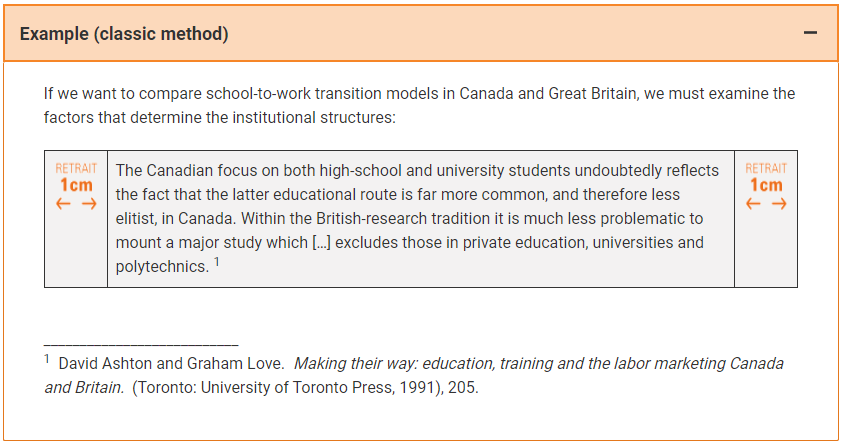
15
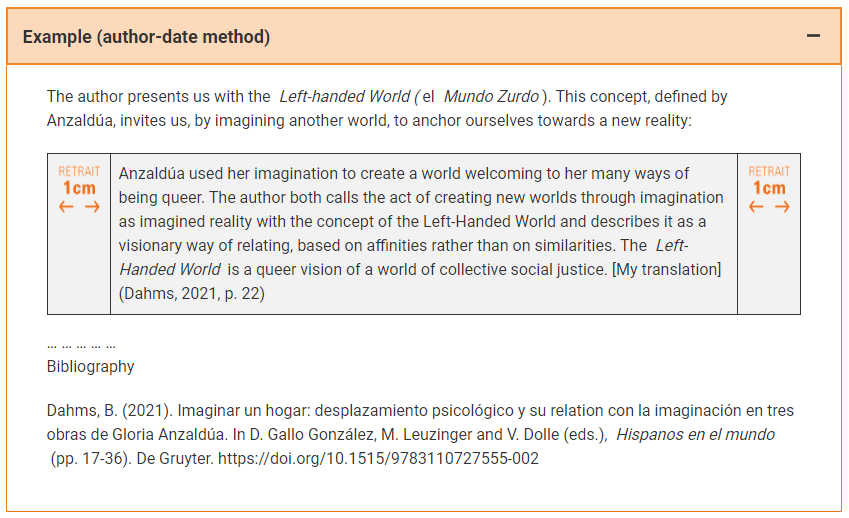
16
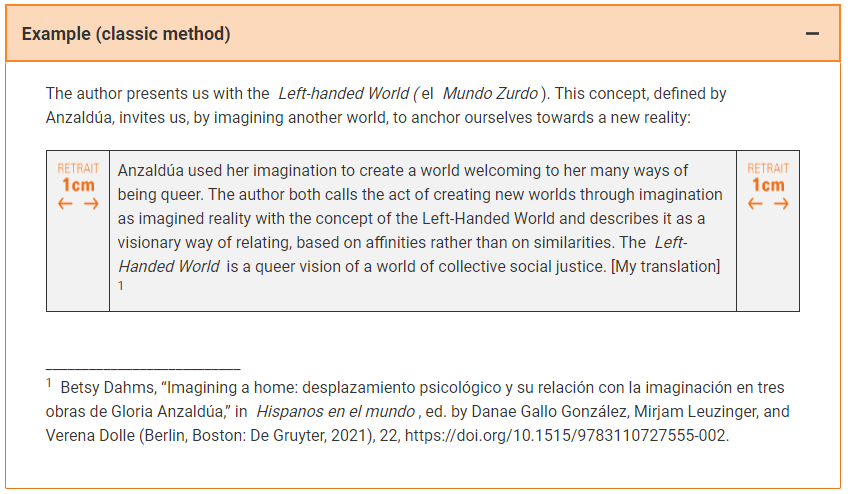
17

18

When first experiencing scholarly writing, there may be discomfort about how to fluidly insert a citation into the body of the text. There are classic turns of phrase that we can use to get started. With experience, introductory formulas will gain in variety and style.
![]() Objective
Objective
![]()
A citation must be included. To do this we use different forms of introduction. The most common forms are presented here.
All textual examples are taken from Matthieu Ricard's book, Plea for altruism: the force of benevolence, published by NiL in 2013.
![]()
The most common formula is the use of the prepositions for and according to.

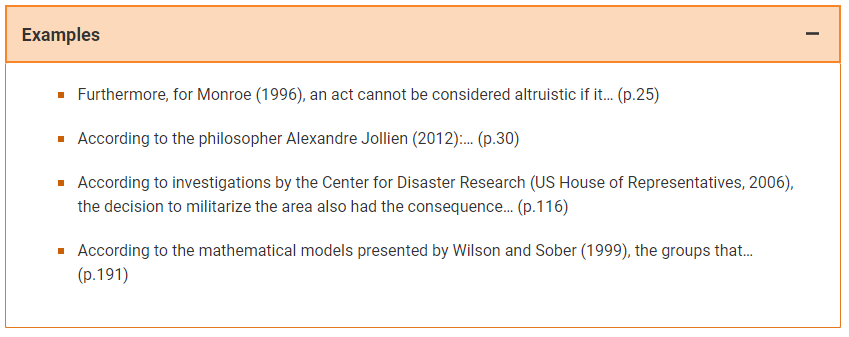
Other expressions are used equivalently such as “In the opinion of X…”, “As for X…”, “From the point of view of X…”, “According to X…”.
![]()
The quotation is commonly introduced by the name of the author(s) as the subject of the sentence, followed by an appropriate verb.

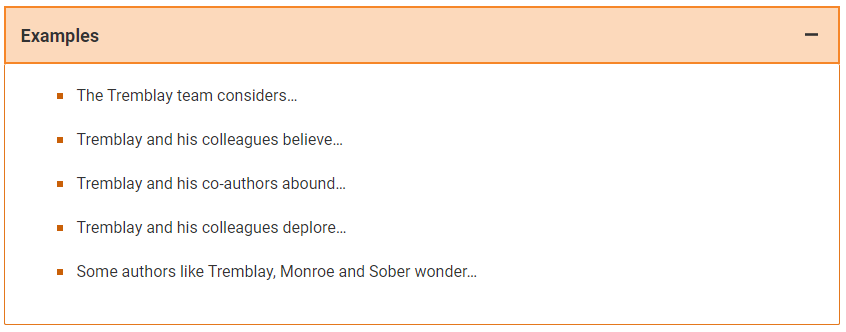
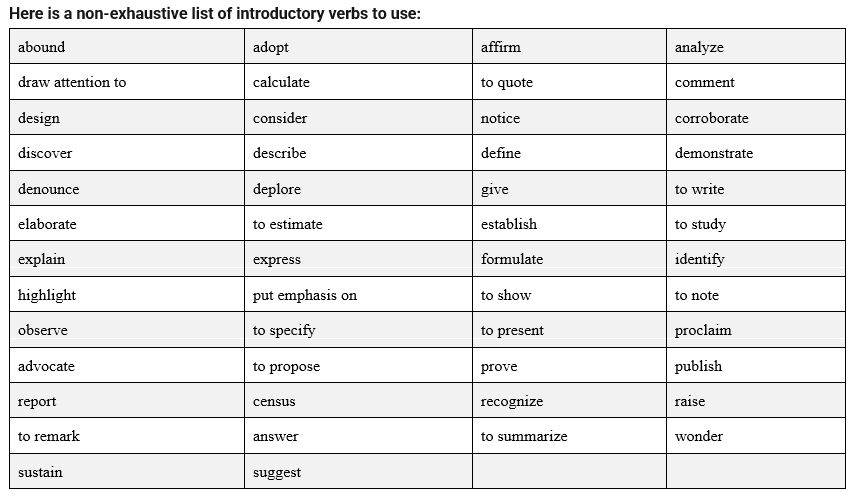
The subject (i.e. the author) and the verb can also be inverted by using the conjunctive phrase as well as or the conjunction like.


![]()
A final, fairly common strategy is to start the sentence with the preposition in followed by the title or type of work that is cited (e.g.: the investigation, the article, the research, the work, the study, the analyzes, experiences).


Other prepositions or adverbs can obviously be used. Ex: According to the article by…; Following the experiences of…
![]()
Three common writing practices were presented. They are based on the use of:
With practice and time, using these formulas will become second nature. More personal and more creative twists will then become possible.
Infosphère / https://infosphere.uqam.ca
To ensure a uniform and professional presentation of your references, always comply with the same formatting criteria. It is the bibliographic style which defines these criteria according to the chosen citation method.
![]() Goals
Goals
![]()
![]()
A bibliography is a “descriptive list of works which allows the identification of each of them” ( La Vitrine ) and which is found at the end of the work.
The bibliography can be specialized on a subject and be the subject of a publication. Very often, it rather groups together all the documents cited or consulted during the writing of a work.
![]()

![]()
The description of the works referenced in the bibliography must respect the guidelines of the adopted bibliographic style.
Check with your department, your dissertation or thesis director, the recommended method for citing your sources and the bibliographic style used to present your bibliography.
If no clear directive is imposed, the university suggests the use of the institutional style, i.e. the ESSCA style.
![]()
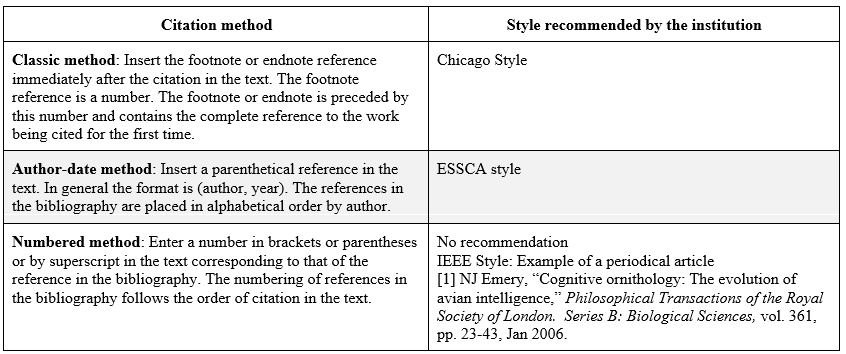
![]()
Infosphère / https://infosphere.uqam.ca
Bibliographic management software is very useful for keeping track of the references consulted and thus protecting against plagiarism situations.
When writing the work, the quotes are inserted without having to worry about their formatting and the bibliography is generated automatically.
Several powerful software programs exist on the market.
![]()
![]()
Here are 3 tutorials to learn how to use these software or applications. To access the information, simply click on the name below.
Infosphère / https://infosphere.uqam.ca
So that a creator can economically enjoy his work, the Copyright Act delimits the context of its protection. This law applies to several types of documents: book, magazine article, web page, images, etc.
The Law authorizes, among other things, students to partial use of the work for personal study and research purposes.
During research work, it is important to respect certain principles in order to use the information collected fairly and honestly and thus avoid plagiarism.
![]()
In addition to the Copyright Act, there are UQAM regulations, and licenses with electronic resource providers.
Some situations may not be covered by these normative texts, in which case personal ethics and professional standards will guide the fair use of information.
![]()
![]() Links/documents
Links/documents

Infosphère / https://infosphere.uqam.ca